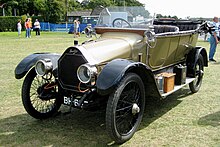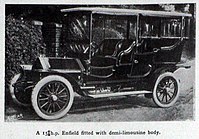Touring car
Touring car and tourer are both terms for open cars (i.e. cars without a fixed roof). "Touring car" is a style of open car built in the United States which seats four or more people. The style was popular from the early 1900s to the 1930s. The cars used for touring car racing in various series since the 1960s, are unrelated to these early touring cars, despite sharing the same name.
"Tourer" is used in
Touring car (U.S.)
Design
Touring car was applied in the U.S. to open cars (cars without a fixed roof, for example
When the top was folded down, it formed a bulky mass known as the fan behind the back seat: fan covers were made to protect the top and its wooden ribs while in the down position. Some touring cars were available with side curtains to protect occupants from wind and weather by snapping or zipping them into place; otherwise, the occupants had minimal weather protection.
History
The touring car body style was popular in the early 20th century, being a larger alternative to the two-seat runabout and the roadster. By the mid-1910s, the touring car body had evolved into several types, including the four-door touring car which was equipped with a convertible top.[3][4]
Most of Model T's produced by Ford between 1908 and 1927 were four and then three-door models (with drivers sliding behind the wheel from passenger seat) touring cars, accounting for 6,519,643 cars sold out of the 15,000,000 estimated Model T's built. This accounted for 44% of all Model T's sold over the model's eighteen-plus year life span, making it the most popular body style.[citation needed]
The popularity of the touring car began to wane in the 1920s when cars with enclosed passenger compartments (i.e. fixed steel roofs) became more affordable, and began to consistently out-sell the open cars.[5]
Demi-Limousine
For a brief time, touring sedans were offered with a solid back and permanent roof, unlike the roof on a touring sedan which could be folded back and stowed. Neither version offered permanent protection from the elements.[6]
Tourer in British English
Tourer is used for open cars.[7]
The belt lines of 1930s tourers were often lowered at the front doors to suggest a more sporting character[8] (however, this only allowed for removable glass or Perspex/Plexiglas side screens; wind-up windows, introduced later, required a more horizonal belt line on the doors).
Just as in the U.S, all-weather tourers are cars with high quality tops and glass side windows;
-
1927Austin 20tourer, front (without side curtains)
-
1927 Austin 20 tourer, rear
-
1951 Ford Anglia tourer: note the lowered beltline at the front door
Torpedo body

The torpedo was a style of 4-seat or 5-seat tourers built from 1908 until the mid-1930s.
See also
- Barchetta – an Italian style of roadster or spyder developed for racing cars after World War II
- Phaeton body – similar to a touring car, but initially lighter and more sporting
- Runabout – a light, open two-seat car, similar to a roadster but with emphasis on economy instead of performance.
References
- OCLC 1645522. Retrieved 31 May 2012.
Here it is, with other body types and distinctions, officially determined recently by the Nomenclature Division of the Society of Automobile Engineers:
- ISBN 0-394-43600-8.
touring car, an open automobile designed for five or more passengers.
- ^ "1927 Ford Model T Touring (Fifteen-Millionth Ford)". www.historicvehicle.org. Retrieved 9 November 2018.
- ^ "The Automobiles". www.fountainheadmuseum.com. Retrieved 9 November 2018.
- Pittsburgh Press. Pittsburgh, PA USA. Automobile Section. Retrieved 2 June 2012.
Interest was centered in the development of low-priced closed models in every automobile factory in the country and the rapid decline of the open car was apparent on all sides.
- ^ Motor Body, Paint and Trim. The Vehicle Monthly. April 1918. p. 16. Retrieved 13 March 2021.
- ISBN 0854292179
- ISBN 0-949757-35-7.
- ISBN 0-5259-3254-2. Retrieved 12 August 2012.
- ^ Georgano & Andersen 1982, p. 683.
- LCCN 79-147885. Retrieved 12 August 2012.
- ISBN 0-7064-0331-2.
Torpedo – Continental term for an open four-seat tourer with soft hood and sporting tendencies and in which the line of the bonnet was continued back to the rear of the car.






